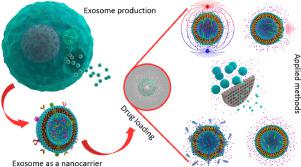Acta Biomaterialia ( IF 9.4 ) Pub Date : 2020-07-02 , DOI: 10.1016/j.actbio.2020.06.036 Fatemeh Mehryab 1 , Shahram Rabbani 2 , Soraya Shahhosseini 3 , Faezeh Shekari 4 , Yousef Fatahi 5 , Hossein Baharvand 6 , Azadeh Haeri 7

|
Exosomes are small nanoparticles secreted by almost all cells and have a well-known role in intercellular communication. They are found in different body fluids and can also be isolated from cell culture media. They contain a natural cargo including various protein and nucleic acid molecules originated from their donor cells. In recent years, exosomes have emerged as a desired drug delivery system. They are believed to provide a targeted delivery of drug molecules, supplemented with their natural function. Furthermore, they have a membranous structure similar to liposomes, and that motivated researchers to apply their previous experience of drug loading into liposomes for exosomes. Herein, we discuss applied methods for the encapsulation of different drugs into exosomes, parameters affecting the incorporation of drug molecules into exosomes, characterization techniques, recent achievements, commercialization challenges and the potential future developments of exosomal drugs. Overall, while the application of exosomes as a drug delivery system is still in its infancy, they are considered to be a new class of natural nanocarriers with great potential for clinical application. Understanding of their key formulation parameters, pharmaceutical properties, in vivo behavior and applicable scale-up production will pave their way to the market.
Statement of Significance
Details of loading methods, characterization and biopharmaceutical properties of drug-incorporated exosomes are presented. Most parameters affecting encapsulation of drugs into exosomes are mentioned to serve as a guide for future studies in this field. Moreover, challenges on the way of exosomes to the market and clinic are described.
中文翻译:

外来体作为下一代药物输送系统:有关药物装载方法,表征和临床应用挑战的最新信息。
外泌体是几乎所有细胞分泌的小纳米颗粒,在细胞间的通讯中起着众所周知的作用。它们存在于不同的体液中,也可以从细胞培养基中分离出来。它们包含天然货物,其中包括来自其供体细胞的各种蛋白质和核酸分子。近年来,外来体已经成为期望的药物递送系统。据信它们提供了补充其天然功能的靶向药物分子。此外,它们具有类似于脂质体的膜状结构,这促使研究人员将他们先前将药物装载到脂质体中的经验应用于外泌体。在此,我们讨论了将不同药物封装到囊泡中的应用方法,影响药物分子掺入囊泡的参数,表征技术,最新成就,商业化挑战以及外泌体药物的潜在未来发展。总体而言,虽然外泌体作为药物输送系统仍处于起步阶段,但它们被认为是一类新型的天然纳米载体,具有巨大的临床应用潜力。了解它们的关键配方参数,药物特性,体内行为和适用的大规模生产将为进入市场铺平道路。
重要声明
介绍了载药方法,药物掺入的外泌体的特征和生物制药特性的详细信息。提及影响药物封装到外泌体中的大多数参数,可以作为该领域未来研究的指南。此外,描述了外泌体进入市场和诊所的方式的挑战。











































 京公网安备 11010802027423号
京公网安备 11010802027423号